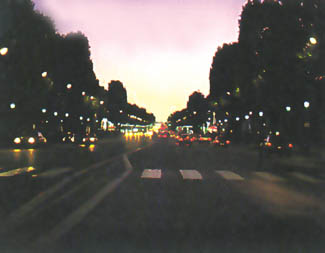1. Does the wind in connection with the speeds developed in a motorway affect the safe movement of your vehicle?
2. When two motor-ways are united, which vehicles should give priority?
-
Those moving on the left branch to those moving on the right branch.
-
Those moving on the right branch to those moving on the left branch.
-
Those moving on the branch which has “Give priority” signs.
3. If you must stop in a motorway:
-
You should switch on the hazard warning lights and, if possible, ensure that the passengers are behind the safety bars.
-
You should place the warning triangle at a distance of at least 50 m.
4. Are you allowed to reverse in an emergency lane?
5. In an emergency lane you can:
-
Stop and relax for a while.
-
Replace a flat tyre.
6. In a motorway while raining:
-
You must switch on your rear fog lights.
-
You must slow down as soon as the rain obliges you to use the windscreen-wipers.
7. In motorways and expressways traffic if forbidden for:
-
Mopeds, horsemen, animal-drawn vehicles and vehicles which cannot develop a speed higher than 50 km/h.
-
New drivers.
-
Lorries.
8. The motorway:
-
Does not have crossroads and traffic on it is safer than in the other road network.
-
Is a road whose both directions are divided by a continuous double line.
9. After driving for long in a motorway you may feel tired. The best you could do in this case is to:
-
Make sure that the vehicle is well ventilated, and, if necessary, stop in a parking place and walk.
-
Increase the speed so as to complete the journey sooner.
-
Switch on the radio, it may help you concentrate.
10. You are driving your passenger car at a high speed in a motorway and you have a flat tyre. What should you do?
-
Hold the steering-wheel firmly, slow down gradually and switch on the hazard warning lights.
-
Brake hard and harsh so as to stop as quick as possible.
11. By mistake you have passed the exit of the motorway from which you wished to exit. What should you do?
-
Continue your course until the next exit.
-
Switch on the hazard lights and reverse in the emergency lane.
12. Does the vehicle that enters a motorway have the right of way?
-
Yes, because it comes from the right.
-
No, because those that move in the motorway have the right of way.
13. When leaving a motorway your perception of speed may cause you to feel that you are moving:
-
At the actual speed.
-
Faster than actually.
-
Slower than actually.
14. In order to leave a motorway or an expressway:
-
You must slow down as soon as you notice the slow-down lane.
-
You must enter the slow-down lane and then reduce speed.
15. The left lane of a motorway with three lanes is recommended to be used by a driver:
-
So that they maintain a normal course.
-
So that they drive at high speed.
-
So that they overtake.
16. In a residential area which is lighted at night, you must drive having the following lights on:
-
Dipped headlights.
-
Full beam headlights.
-
Side lights only.
17. You must change from full beam headlights to dipped headlights:
-
At crossings.
-
On the top of a slope.
-
Before meeting a vehicle that comes from the opposite direction or when you follow a vehicle.
18. Outside a residential area at night:
-
You must use the full beam headlights.
-
You must use only the dipped headlights.
19. In case of fog:
-
Switch on the dipped headlights and fog lights.
-
Switch on the side lights only.
20. In order to have a better visibility in case of fog, you can:
-
Activate the anti-misty mechanisms and windscreen wipers on their slow mode.
-
Switch off the ventilation system.
21. Under normal traffic conditions, in order to use the left lane in a motorway, you should:
-
Attempt to overtake.
-
Move at a speed of at least 80 km/h.
22. In every journey the driver must take rest breaks at a place of permissible parking every:
-
Six hours.
-
Four hours.
-
Two hours.
24. In the motorway the speed of the passenger cars is restricted to:
-
150 km/h under sunlight.
-
120 km/h under normal weather conditions.
-
110 km/h in a pelting rain.
25. In a motorway, you can park:
-
In the emergency lane.
-
In suitable formed spaces.
-
In the sides (haunches).
26. In a motorway during overtaking:
-
You ignore what happens behind your vehicle if you are driving at 130 km/h.
-
You can exceed the speed limit.
-
You can continue moving in your lane so as to overtake many vehicles simultaneously.
27. Have you selected the suitable lane in order to follow the exit?
28. Emergency stop is a stop of the vehicle, where:
-
The vehicle has a failure or the driver does not feel well.
-
A passenger wishes to take a photograph of a landscape.
29. In the motorway, are the points where you are allowed to park indicated by traffic signs?
30. In the motorway in case of dense fog:
-
You should drive astride on the borderline.
-
You should switch on the dipped headlights and drive at a speed of up to 50 km/h.
-
You should follow the red lights ahead of you as close as possible.











